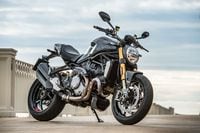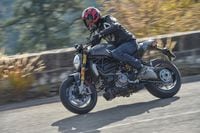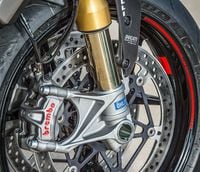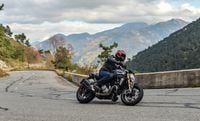I will raise my hand. I admit it: When the 2017 Monster 1200 was announced I thought it was a simple facelift. I thought Ducati drizzled some new styling over a quickshifter and a reshaped fuel tank and then begged us to be excited about it. But I wasn't paying attention. This new machine has significant updates, top to bottom. Easily my favorite part is that Ducati didn't follow the trend of bigger and more. Instead, the new Monster is more technologically advanced but also narrower and shorter.
First of all, I need to specify (lest all stat nerds protest) that the 2017 Monster 1200 does have a taller standard seat height—31.3 inches, up from 30.9 inches, due to a longer shock. More to the point, Ducati made the tail section and tank slimmer by around 20mm (0.75 inches). The tank’s capacity is also down about a quarter of a gallon for 4.4 gallons total. An all-new, shorter swingarm accounts for the 58.5-inch wheelbase, a full inch less than the previous model.
I should also say the new Monster is not lighter. Ducati claims 465 pounds, four more than the last 1200 S (which tipped our scales at 475 pounds with a full tank). The extra weight for 2017 falls in line with the chat I had with Giuseppe Caprara, project engineer for the new Monster 1200, who said making the bike legal for Euro-4 standards meant making the exhaust bigger, and nearly 4.5 pounds heavier, among other things. That’s not to mention the things the new bike has that the previous model did not: Namely an inertial measurement unit (IMU) and a quickshifter.
From the saddle, this bike feels very much like the 1200 S that it replaces. The engine is now the same spec as the R-model Monster but with smaller diameter exhaust and different fuel mapping. There are 150 claimed horses on tap, five up from last year’s bike—which eventually cranked out 130 horsepower on our dyno. It’s plenty fast, in other words, and delivers enough torque to shrink a hairpin curve or a doddering sedan in the mirrors with a flick of the wrist. And taking the quickshifter from the 1299 Panigale means getting up and down the gearbox is easier than ever. No need to touch the clutch or let off the throttle, just shift to your left-foot’s content. Speaking of horsepower and shifting, the new IMU means wheelie control can be instituted, and in fine fashion can also be disabled independently of the standard traction control.
I experimented pretty extensively with just how “off” wheelie control could get, and found the answer to be “very off.” Yes, mom, I tried it with wheelie control on, too. It works just fine. Happy? What I did not push the limits of was cornering ABS, also brought to you by the power of the IMU (the more lean, the more conservative the ABS). It’s a great safety feature, and we’ve sampled it before, but it’s not the type of system to fool around with on a borrowed bike and cold, French pavement—especially in the wake of seeing another poor journalist sprawled out in the road, dignity sacrificed to the hooligan gods. I can report that the brakes are stout, though: Brembo’s fancy M50 monoblock calipers, standard issue for any Ducati that wants to be taken seriously, squeezing 330mm discs. It’s up-market kit, and one of the few times that a single index finger will lift the rear wheel of a motorcycle.
Are you the “Monstrous” type who cares more for comfort than corner carving? Well then, bask in the three familiar Ducati power modes/maps (Sport, Touring, and Urban) with full adjustability, a redesigned seat, an updated TFT dash, and rubber-damped footpegs that soak up 1,198cc of shuddering V-twin. And then there are the Öhlins suspension pieces, so monotonously good that we’ve simply run out of adjectives to describe them. Firm, comfortable, responsive, and well-calibrated, all wrapped up in gold. Touring types will think the springs are too stiff, but more sportif riders are likely to love the Swedish suspenders on this 1200 S.
To borrow a tired old analogy, it feels like last year’s Monster 1200 hit the gym. It’s not actually smaller, but it looks leaner, has a little more power, and feels like it’s lighter on its feet. That’s the real takeaway here: The new Monster isn’t lighter or less complicated, but practically it’s a shift in that direction. It’s narrower and stubbier visually, and also more compact mechanically. Objectively, it is a step back toward the original Monster in feel and appearance. In my opinion, it’s a clear improvement.
Maybe reviving the air-cooled Monster with the 803cc legacy engine (to create the new 797) shook something loose at Ducati. I like to picture a test rider or engineer taking the 797 or an old M900 for a test ride and thinking, "Oh yeah... this is what a Monster is supposed to feel like." Then returning to the factory and drafting an email to the team with the subject line, "No more 60-inch wheelbase!" And that is one reason that this new Monster makes me happy. It feels like the Ducati of old, poking its head out from under all of the trends and complications of building a motorcycle today.
Pricing for the new Monster 1200 starts at $14,695. That’ll get you a base bike, with a fully adjustable KYB fork and Sachs shock instead of the Öhlins bits on the bike I rode. The base bike also comes with more plebian four-pot Brembo calipers (not the M50s) squeezing 320mm rotors, different wheels, and no carbon fiber front fender or quickshifter (it’s an optional accessory). You also can’t have the Liquid Concrete Gray colorway like the S model in the photos. For all of the high-end stuff, you’ll be out $17,195 (or $16,995 in red).



















/cloudfront-us-east-1.images.arcpublishing.com/octane/XA5JI4GJR4VGXDFLXTPNIWEFNI.jpg)
/cloudfront-us-east-1.images.arcpublishing.com/octane/MUQLOVLL2ZDGFH25ILABNBXKTI.jpg)
/cloudfront-us-east-1.images.arcpublishing.com/octane/TNOU5DNE2BC57MFPMGN2EIDXAM.jpg)
/cloudfront-us-east-1.images.arcpublishing.com/octane/GTCXACQGJ5HAPDTGWUQKDEH44E.jpg)
/cloudfront-us-east-1.images.arcpublishing.com/octane/S35YGSEMEZB4BLTDJTSZPF4GLA.jpg)
/cloudfront-us-east-1.images.arcpublishing.com/octane/5UOT6HPX2JFMRJAX6EH45AR4MQ.jpg)
/cloudfront-us-east-1.images.arcpublishing.com/octane/OKWOJWAKP5EP3OACCRRWPCIX2Q.jpg)
/cloudfront-us-east-1.images.arcpublishing.com/octane/2WF3SCE3NFBQXLDNJM7KMXA45E.jpg)
/cloudfront-us-east-1.images.arcpublishing.com/octane/G4MG6OUCJNBSHIS2MVVOTPX65E.jpg)
/cloudfront-us-east-1.images.arcpublishing.com/octane/IIGGWFOTOJGB7DB6DGBXCCMTDY.jpg)
/cloudfront-us-east-1.images.arcpublishing.com/octane/QSTCM6AVEZA5JJBUXNIQ3DSOF4.jpg)
/cloudfront-us-east-1.images.arcpublishing.com/octane/U4I7G625B5DMLF2DVIJDFZVV6M.jpg)
/cloudfront-us-east-1.images.arcpublishing.com/octane/B6XD6LS6IVCQPIU6HXDJSM3FHY.jpg)
/cloudfront-us-east-1.images.arcpublishing.com/octane/ICL63FEDDRDTTMINYICCEYGMDA.jpg)
/cloudfront-us-east-1.images.arcpublishing.com/octane/FCGZHQXRBZFLBAPC5SDIQLVF4I.jpg)
/cloudfront-us-east-1.images.arcpublishing.com/octane/WNOB6LDOIFFHJKPSVIWDYUGOPM.jpg)

/cloudfront-us-east-1.images.arcpublishing.com/octane/X33NU3E525ECRHXLNUJN2FTRKI.jpg)
/cloudfront-us-east-1.images.arcpublishing.com/octane/6KKT5NNL2JAVBOXMZYS5ZO76YA.jpg)
/cloudfront-us-east-1.images.arcpublishing.com/octane/J5RKG5O455GMPGQRF2OG6LRT7A.jpg)
/cloudfront-us-east-1.images.arcpublishing.com/octane/GX2CIZKQVRH2TATDM26KFG2DAE.jpg)
/cloudfront-us-east-1.images.arcpublishing.com/octane/ZWIDYSAKQZHD5BHREMQILXJCGM.jpg)
/cloudfront-us-east-1.images.arcpublishing.com/octane/CYUHJZCTSJCH3MRAQEIKXK7SCQ.jpg)
/cloudfront-us-east-1.images.arcpublishing.com/octane/LKOFINY56FCXJCANJ5M7ZDQUBY.jpg)
/cloudfront-us-east-1.images.arcpublishing.com/octane/4NBPDACMWJH63JQYJVK3QRBDZI.jpg)